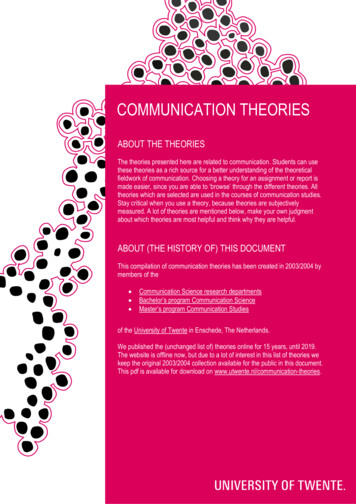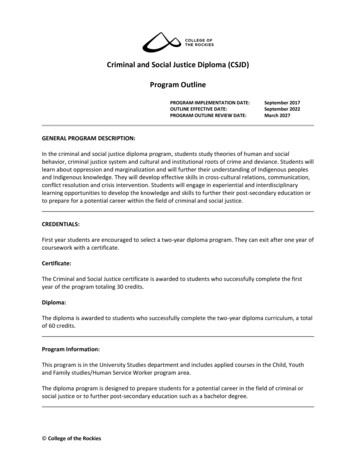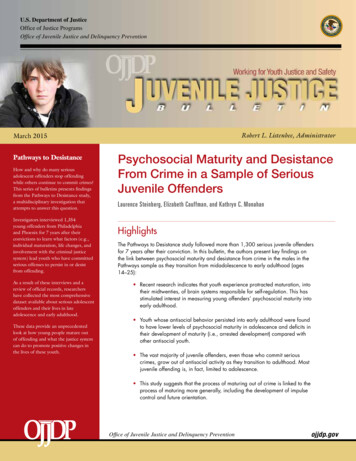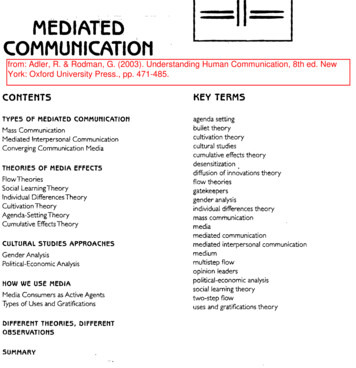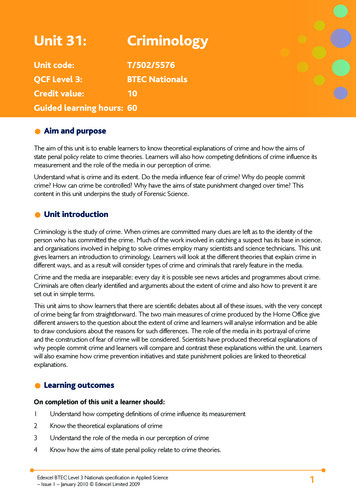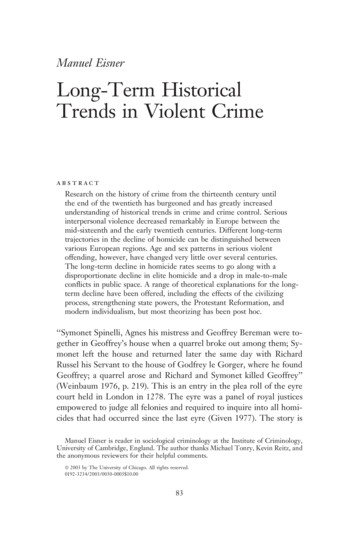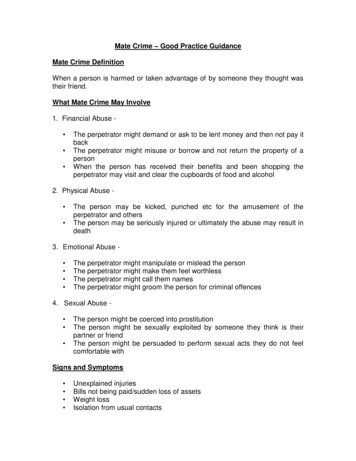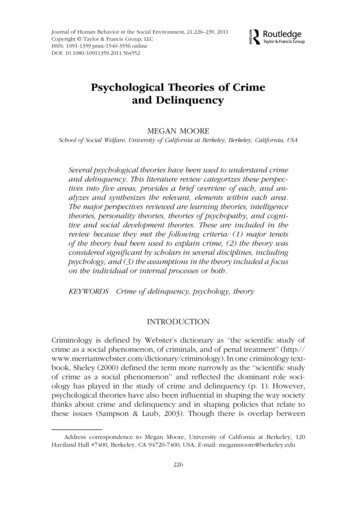
Transcription
Journal of Human Behavior in the Social Environment, 21:226–239, 2011Copyright Taylor & Francis Group, LLCISSN: 1091-1359 print/1540-3556 onlineDOI: 10.1080/10911359.2011.564552Psychological Theories of Crimeand DelinquencyMEGAN MOORESchool of Social Welfare, University of California at Berkeley, Berkeley, California, USASeveral psychological theories have been used to understand crimeand delinquency. This literature review categorizes these perspectives into five areas, provides a brief overview of each, and analyzes and synthesizes the relevant, elements within each area.The major perspectives reviewed are learning theories, intelligencetheories, personality theories, theories of psychopathy, and cognitive and social development theories. These are included in thereview because they met the following criteria: (1) major tenetsof the theory had been used to explain crime, (2) the theory wasconsidered significant by scholars in several disciplines, includingpsychology, and (3) the assumptions in the theory included a focuson the individual or internal processes or both.KEYWORDS Crime of delinquency, psychology, theoryINTRODUCTIONCriminology is defined by Webster’s dictionary as ‘‘the scientific study ofcrime as a social phenomenon, of criminals, and of penal treatment’’ ogy). In one criminology textbook, Sheley (2000) defined the term more narrowly as the ‘‘scientific studyof crime as a social phenomenon’’ and reflected the dominant role sociology has played in the study of crime and delinquency (p. 1). However,psychological theories have also been influential in shaping the way societythinks about crime and delinquency and in shaping policies that relate tothese issues (Sampson & Laub, 2003). Though there is overlap betweenAddress correspondence to Megan Moore, University of California at Berkeley, 120Haviland Hall #7400, Berkeley, CA 94720-7400, USA. E-mail: meganmoore@berkeley.edu226
Psychological Theories of Crime and Delinquency227sociological and psychological theories, this literature review identifies andsynthesizes five major theories in the field of psychology related to crimeand delinquency.The review is divided into the following categories: learning theories,intelligence theories, personality theories, theories of psychopathy, and cognitive and social development theories. These categories represent a synthesis of psychological concepts that help to explain crime and delinquency(Shoemaker, 2005; Siegel, Welsh, & Senna, 2006). In addition to describing the elements of each theory, the review concludes with a figure thathighlights the concepts and illustrates how they relate to one another.METHODOLOGYTwo methods were used to identify the literature reviewed for this article.First, a computer search was completed using the University of CaliforniaBerkeley online library databases and Google Scholar. Second, an expertin the area was consulted to provide additional resources. The UC librarydatabases searched include PsycINFO and PsycARTICLES; these core psychological databases provide search information for all CSA Illumina SocialSciences databases. In addition, the University of California Melvyl bookand article database was searched because it includes all of the UC holdings (e.g, books, articles, magazines, and governmental publications). Initialsearches included the following keywords: psychological theory and crime,psychological theory and delinquency, crime and delinquency, theory anddelinquency, theory and crime, IQ and delinquency, and truncated termspsych* and theor* and delinqu*, psych* and delinqu*, and psych* and theor*and crim*. After consultation with a scholar in the field, additional searcheswere completed to locate publications by the following key theorists: TravisHirschi, John Laub and Robert Sampson, Terrie Moffitt, Jerome Kagan, andJerry Patterson. Once several key articles were identified, frequently citedarticles were also searched and identified.There are several limitations in the search methods listed here, especiallywith regard to the overlap between the psychological and sociological theories of crime and delinquency. As the search focused primarily on psychological theories, those theories with extensive sociological overlap were notreviewed. A second limitation relates to the brevity of the literature review;therefore it does not represent a comprehensive review of all psychologicaltheories in this area.Psychological Theories of Crime and DelinquencyTheories of crime and delinquency tend to use either macro- or micro-levelsof analysis. Typically, the field of sociology has addressed crime and delin-
228M. Moorequency at the macro-level, primarily looking for societal and environmentalinfluences that lead to criminal behavior. Psychological theories tend toaddress crime and delinquency at the individual level, primarily identifyingindividual differences that lead to criminal behavior. Although debates aboutthe merits of micro- and macro-levels of analysis still exist, many modernstudies of crime and delinquency aim to identify multiple contributing factorsand often attempt to explain both micro- and macro-influences on criminalbehavior.Some psychological theorists attempt to provide a framework foridentifying the correlational relationships between psychological variables(pathology) within a person and that person’s delinquent behavior whileothers attempt to understand contingencies responsible for maintainingnon-conforming behavior labeled deviant. Deviance from this perspectiveis understood as ‘‘ways, which the person has learned, of coping withenvironmental and self-imposed demands’’ (Bandura, 1969, p. 2). This reviewbegins with an overview of learning theories.LEARNINGTHEORIESLearning theories represent the ‘‘study of circumstances under which a response and a cue stimulus become connected (Miller & Dollard, 1941, p. 1);they have been discussed in the literature since the 19th century. The firstempirical studies of learning have been attributed to Edward Thorndike(Pavlov, 2010/1927). Thorndike conducted animal studies demonstrating acat could learn to associate the behavior of getting out of box with obtaining food that was placed outside the box and hasten the task over time(Thorndike, 1898). This work established an important principle that wouldinfluence future research on learning (Kazdin, 1989). He established the ‘‘Lawof Effect, which states that consequences that follow behavior help learning(Kazdin, 1989, p. 10). Around the same time, but without knowledge ofThorndikes work, Ivan Pavlov was conducting studies on a different typeof learning (see Pavlov, 2010/1927). He was measuring and conditioningsalivation and other physiological reflexes in dogs to respond to neutralstimuli (see Pavlov, 2010/1927), later called classical conditioning. Focusingon the consequences of behavior rather than the eliciting stimuli, Skinner(1938) postulated that behavior has an influence on the environment. Thefrequency of behavior is determined by environmental consequences andcan be altered by modifying the environmental conditions (Skinner, 1963).He explicated operant conditioning.Others were more interested in internal determinants of behavior. Rotter(1954) proposed a social learning theory of personality that emphasizedthe role of learned behavior and experience in the interaction of personand environment determinants of behavior. Citing the influential work ofKantor (1924) who proposed that behavior resulted from the interaction ofthe person and stimulus in environment and Lewin (1935) who suggested
Psychological Theories of Crime and Delinquency229that behavior is determined by the person and their environment in time andspace, the thrust of this theory focused on how behavior is shaped by experience. Bandura (1969) discussed the principles of modifying behavior usingsocial learning theory. Later labeled social cognitive theory (Bandura, 1986),social learning theory posits the interaction of (1) observation, symbolicrepresentations and self-generated stimuli and self-imposed consequences,(2) environmental conditions and (3) behaviors in determining behavior.The theory ‘‘favors a model of causation involving triadic reciprocal determinism behavior, cognition and other personal factors, and environmentalinfluences all operate as interacting determinants that influence each otherbidirectionally (Bandura, 1989, p. 2). Social learning theorists posit that theconditions by which behavior is shaped include internal and external forces,and that behavior itself is a determinant of future behavior (Bandura, 1969).Deviant, criminal or delinquent behavior, like all behavior, results from thismodel of causation.Learning theories have been influential in understanding criminal behavior. A theory of differential association was posited; criminal behavioroccurs in a context of cultural conflict where association with criminalsincreases criminal behavior (Sutherland, 1939). Differential association theorywas expanded and refined by Burgess and Akers (1966) to incorporate thebehavioral and social learning theories. They defined differential associationreinforcement theory. These theorists posited that in addition to differentialassociation with deviant peers, differential reinforcement of deviant behaviors is also required to explain criminal behavior. Building on the writingsof B.F. Skinner, this theory focuses on the use of operant conditioning inlearning criminal behavior (Burgess & Akers). Operant conditioning is theprocess by which an environmental stimulus elicits a voluntary response,and the response is either positively or negatively reinforced, which affects its continuation or discontinuation (Skinner, 1963). If a behavior isrewarded, it will be continued, and if the behavior is not rewarded, itwill be discontinued or extinguished (Skinner). Over time, a pattern ofbehavior develops, and the learned behavioral reactions are internalized(Siegel et al., 2006). ‘‘The strength of criminal behavior is a direct functionof the amount, frequency, and probability of its reinforcement’’ (Burgess &Akers, p. 146). In addition, definitions or internalized, learned norms andimitation account for development of deviant behavior (Akers et al., 1979).In testing this theory, a ‘‘vicarious-reinforcement’’ hypothesis was supported;as a delinquent attracted attention, peers increased their delinquency to gainthe same attention (Rebellon, 2006, p. 403). There is extensive empiricalsupport for the successful application of learning theory principles to modifybehavior (see for instance the works of Albert Bandura, B. F. Skinner, andIsrael Goldiamond, among others). Because these principles can be appliedto behaviors of all kinds, the learning perspective provides valuable toolsfor understanding crime and delinquency.
230INTELLIGENCEM. MooreTHEORIESIdeas about a connection between intelligence and delinquency are longstanding and much debated by scholars. When IQ became the measure ofintelligence, Goddard sparked an intense debate with his published reportabout ‘‘feebleminded inmates,’’ which erroneously led him to conclude thatcriminal behavior was caused by low intelligence (Goddard, 1914, as citedin Shoemaker, 2005). Several subsequent studies were unable to replicateGoddard’s work, so studying intelligence among criminals fell out of favor(Shoemaker). For many years, sociological research did not pursue individually focused explanations for criminal behavior, and that resulted in theomission of explicit links between intelligence and delinquency, despite thefact that many researchers implicitly assumed the relationship (Hirschi &Hindelang, 1977).In addition, many researchers continue to be concerned about the misinterpretation of IQ-delinquency data because a narrow focus on IQ asa cause of delinquency can direct researchers to misleading conclusionsabout heredity, race, and class (McGloin, Pratt, & Maahs, 2004). Studiesattempting to find a causal link between intelligence and deviance have alsobeen criticized for methodological reasons, including ‘‘wide variation in IQscores among both criminals and noncriminals; evidence that good schooling: : : is related to high IQ test scoring : : : low motivation is associated withlow scoring; and : : : the gap between prisoner scores and : : : the generalpopulation is greatly reduced when comparisons are made with peopleof similar economic, linguistic, and educational backgrounds’’ (Pfohl, 1994,p. 113).Currently, research focuses on the effect of IQ on delinquency amongother important risk factors and various explanations of delinquent andcriminal behavior, namely, whether the relationship is direct and causal orindirect and mediated by other factors such as school performance (McGloinet al., 2004; Moffitt, 1990, as cited in Moffitt, 1993).Some studies have reported that delinquents have lower IQ scoresthan nondelinquents (Hirschi & Hindelang, 1977), and a connection between low IQ and delinquency has been posited (Lynam et al., 1993). Intheir influential review, Hirschi and Hindelang concluded that intelligencehad an effect on delinquency, and this effect had an inverse correlationthat was independent of class and race. They focus their interpretationsof these conclusions on the mediating factor of school performance, indicating that students with lower IQ scores did poorly in school, gainedless acceptance, had fewer opportunities to excel at school and then, as aresult, looked for acceptance and opportunities elsewhere. The power of theschool as a device of social control was diminished for these students. Assuggested in an earlier publication, this lack of social control (the school)led to increased delinquent acts (Hirschi, 1969). This analysis has been
Psychological Theories of Crime and Delinquency231extended to include deviant peer pressure and self-control as other mediatingfactors in the indirect link between IQ and delinquency (McGloin et al.,2004).Other scholars have tested the connection between IQ and delinquencyand reported a causal link between the two (Lynam et al., 1993; Moffitt,Gabrielli, Mednick, & Schulsinger, 1981), and a causal link between low IQand antisocial behavior (Koenen, Caspi, Moffitt, Rijsdijk, & Taylor, 2006).Each of the studies also indicated that school performance was a mediatingfactor for the effect of IQ on delinquency. For example, one study found thatthe effect of IQ on delinquency was mediated by school performance only forAfrican-American youths (Lynam et al.). Another study found that IQ was onepart of a three-stage pathway to delinquency; low IQ in combination withhigh anxiety and depression contributes to delinquent behaviors (Leech, Day,Richardson, & Goldschmidt, 2003). The children involved in this pathwayalso had more problems in school (Leech et al.).Therefore, any relationship between IQ and delinquency is most likelyindirect. Specifically, IQ impacts mediating factors such as performance inschool, self-control, the influence of deviant peer pressure, and psychologicalwell-being. These factors influence delinquent behavior. Therefore, it is theimpact that IQ has on these factors that indirectly links it to delinquency.Studies of the intelligence and deviance link should be viewed with cautiondue to methodological challenges discussed above, and interpretations ofthis work must be made carefully.PERSONALITYTRAIT THEORIESTheories that explain crime and delinquency as a result of personality traitsfocus on delinquency as an externalizing behavior representing internalpathology. Representing a large literature, two prominent theories are thepsychodynamic-psychoanalytical theory and the personality trait theory. Thegoal here is to summarize the main points.The psychodynamic-psychoanalytic theory, developed from the writingsof Sigmund Freud, posits that personality is developed early in life and iscomposed of three distinct parts: the id, the ego, and the superego (Siegelet al., 2006). The id represents the instinctual drives, the ego representsunderstood social norms that harness the id, and the superego is learnedmoral reasoning (Siegel et al.). Delinquent behavior occurs as a result ofimbalance between these three parts of our personality and is thought tobe a symbolic way of meeting our unconscious needs (Siegel et al.). Theinternal conflicts that lead to delinquency, usually resulting from a conflictbetween the id and societal norms understood by the ego, are very painfulto the individual, so the individual pushes them into the unconscious (Shoemaker, 2005). Then, the individual develops coping strategies called defensemechanisms to cope with the conflicts, and these defense mechanisms can
232M. Moorelead to problematic personality traits and problematic behaviors, such asdelinquency (Shoemaker). In essence, delinquent behavior is seen as theexternal manifestation of an internal disease (Shoemaker).Erikson expanded on this theory, explaining delinquency as an ‘‘identitycrisis’’ created by inner turmoil (Siegel et al., 2006). As has been noted bymany critics of psychoanalytic theory, this identity crisis created by innerturmoil is difficult to test empirically. The utility of psychoanalytic theoryto explain complex, delinquent behavior is limited by the lack of evidenceto support it (Shoemaker, 2005; Siegel et al.) and by the ‘‘circular nature’’of psychoanalytic thought (Pfohl, 1994, p. 121). That is the unconsciousmanifestations of pathology are ‘‘inferred from behavior’’ and that behavioris interpreted as a symptom of the pathology (Pfohl, 1994).In the 1950s, Sheldon and Eleanor Glueck conducted studies on 500boys and highlighted the personality and delinquency link in some of theirfindings (Glueck & Glueck, 1950, 1952). Their interpretation of the findingsindicated that when compared with nondelinquents, delinquent boys were‘‘less cooperative,’’ more ‘‘suspicious,’’ ‘‘more destructive,’’ more ‘‘defensive,’’and had ‘‘conscious or unconscious hostile impulses,’’ (Glueck & Glueck,1952, p. 152). In addition, they reported more severe ‘‘mental pathology’’ inthe delinquent boys (Glueck & Glueck, 1952, p. 162). Their work, althoughcriticized for its inexact methods, inspired other researchers to examinepersonality and psychiatric disorder in connection with delinquency (Shoemaker, 2005). Others have attempted to link antisocial and aggressive behavior and low self-esteem to delinquency (Donnellan, Trzesniewski, Robins,Moffitt, & Caspi, 2005).The psychodynamic-psychoanalytic theory and the various personalitytrait theories attempt to identify common characteristics of delinquents andprovide frameworks to guide interventions that may dissuade an individualfrom demonstrating destructive behaviors. The challenge to these theoristsrests in the difficulty of testing such hypotheses and in taking into accountthe vast variability in human behavior.Theories of PsychopathyTypically, theories of psychopathy are used to describe more serious andviolent delinquent acts. Theorists view serious and persistent crime anddelinquency as an outward manifestation of mental illness. The main difference between these theories and the personality theories described earlierlies in the distinction that psychopathy theorists make between individualtraits, which are the focus of personality theories, and a state of beingthat includes several distinct traits and comprises a disorder, which is thefocus of psychopathy theories. Antisocial personality disorder, also calledpsychopathy, is the prominent disorder used to explain criminal behaviorfrom this viewpoint. In addition, reinforcement sensitivity theory explains
Psychological Theories of Crime and Delinquency233delinquent behavior using a biological lens. It is briefly described in thissection due to its framing of delinquency as a state created by a chemicaldisorder or imbalance.Antisocial personality disorder (APD), a psychiatric disorder, as listed inthe American Psychiatric Association’s Diagnostic and Statistical Manual-IVTR (DSM-IV), has been closely studied in connection with crime and delinquency (Shoemaker, 2005; Siegel et al., 2006). The criteria for the disorderinclude a pattern of violation of the rights of others, including law-breakingactivities that began in childhood or early adolescence (DSM-IV, 2000). Thereis debate about the utility of APD to be used synonymously with psychopathyas the diagnostic criteria for APD does not include some of the core traitsbelieved to be a part of psychopathy (Blackburn, 1998).Psychopathy was described as a ‘‘socially devastating personality disorder defined by a constellation of affective, interpersonal, and behavioralcharacteristics, including : : : a propensity to violate social and legal expectations and norms’’ (Hare, 1998, p. 105). Based on the DSM-IV criteria,the United States prevalence in the general population is estimated to beabout the same as that of schizophrenia (about 1%; Hare, 1993). In prisonpopulations, rates of psychopathy are much higher at about 20%, and itis estimated that psychopaths commit 50% of serious crimes (Hare, 1993).The key symptoms are broken into two categories: emotional/interpersonal(e.g., glib, superficial, egocentric, grandiose, lacking empathy) and socialdeviance (e.g., impulsive, lack of responsibility, poor control of behavior,need for excitement, antisocial behavior; Hare, 1993). Criminal and delinquent behavior is a hallmark of the disorder. These symptoms are includedon a widely used clinical tool, the Psychopathy Checklist, in the hopes ofidentifying psychopathic individuals (Hare, 1993). If psychopaths can bereliably identified, there may be interventions that can be enlisted to preventor desist the behaviors that these individuals often exhibit.Taking a look at delinquency through a more biological lens, Eysenck(1964) reported that delinquents had lower cortical arousal levels and lessability to be conditioned by social norms than nondelinquents, and thosetraits can lead to increased extraversion and neuroticism in the criminal.Gray’s (1970) reinforcement sensitivity theory, a revision and extension ofEysenck’s theory, helped to identify introverts as more sensitive to punishment and non-reward but found that they were not more easily conditioned.This sensitivity to punishment and non-reward lead to decreased delinquentbehavior. In addition, reinforcement sensitivity theorists stated that therewas a physiological basis for introversion, which consists of the ascendingreticular activating system and the inhibitory system of the orbital frontalcortex, medial septal, and hippocampus (Gray, 1970). This research has beencriticized for a lack of focus on social factors that impact physiology andthe differential opportunities people have for extroversion and introversion(Pfohl, 1994).
234M. MooreBy clustering personality characteristics and linking them to behavior(e.g., antisocial personality disorder, psychopathy, and delinquent behavior),these theorists attempt to identify and intervene with individuals at risk ofdelinquent behavior. Conversely, linking personality clusters to certain behaviors leads to the use of negative labels. These labels, in and of themselves,can be harmful.Cognitive and Social Development TheoriesCognitive theorists focus on mental processes that assist us in ordering andunderstanding our world and in engaging in problem solving (Siegel et al.,2006). Piaget identified and labeled the step-wise approach to the development of reasoning and morals in children (Siegel et al.). The age-relatedstages include the egocentric stage, the concrete operational stage, and theformal, cognitive operational stage whereby an individual can use abstractthinking, logic, and rules to navigate a situation (Feldman, 1977). Kohlbergexpanded the idea of developmental stages of reasoning and connected themto crime and delinquency; he outlined six stages of development (obediencepunishment orientation, self-interest orientation, interpersonal accord andconformity, social-order maintaining orientation, social contract orientation,and universal ethical principles; Siegel et al.). These stages culminate in theautonomy of individuals to use personal and universal principles (that maygo beyond the rule of law) to maintain the rights of others (Feldman).Others have continued in the developmental tradition while studyingdelinquency. One such influential theory is Catalano and Hawkins’ (1996)social development model that accounts for the development of pro-socialand antisocial behaviors through similar processes in four distinct periodsof time: pre-school, elementary school, middle school, and high school.The development of antisocial behavior can be cumulative and increasingin direction. This is because the connection with antisocial peers, family,and activities in one period of time can increase chances of continuingthose behaviors in a later period of development (Catalano & Hawkins).These antisocial behaviors and interactions also decrease the likelihood ofengaging in positive peer relationships and activities (Catalano & Hawkins).One study testing the predictive potential of involvement in after-schoolactivity and delinquency found a modest protective influence of involvementin structured activity for delinquents and a more robust positive correlationbetween involvement in unstructured activity and delinquency in high school(Fleming, Catalano, Mazza, Brown, Haggerty, & Harachi, 2008). Thoughpromising, more research is needed to test and validate the social development theory of delinquency.Drawing upon Hirschi and Gottfredson’s (1983) research related to thehigh rate of delinquency in adolescence, Moffitt (1993) created the developmental taxonomy of two patterns of antisocial, delinquent behavior:
Psychological Theories of Crime and Delinquency235‘‘adolescent-limited and life-course-persistent.’’ Moffitt (1993) reported thatthe increased rate of delinquency in adolescence indicated that delinquentbehavior was a normative part of development, which peaked in the teenyears and then desisted (Moffitt, 1993). However, there was a small numberof delinquents that continued to offend into adulthood and developed a‘‘pathological personality,’’ and it is of importance for interventionists to distinguish between these two groups (Moffitt, 1993, p. 647). Several risk factorsfor the life course persistent type were identified and included neurologicaldamage and difficult temperament in infancy, difficult parental temperament,environments that promote criminal values, problematic child and parent interactions, and inability to overcome obstacles that lead to decreased optionsfor non-criminal success (Moffitt, 1993). In short, the life course persistenttype of offenders reflected the interaction of risky behaviors, genetic traits,and poor environment (Moffitt, 1993). It is hypothesized that this type ofbehavior is pathological (Moffitt, 1993). Several studies provide support forthe hypothesis that antisocial behavior in childhood is linked to adolescentdelinquency (Broidy et al., 2003) and that psychopathology in early adolescence can be stable and predictive of adult psychopathology (Lynam et al.,2007; Lynam & Gudonis, 2005).The challenge to the life course taxonomy perspective is found in theresearch on adult criminal offenders who began offending in adulthood (notas juveniles; Eggleston & Laub, 2002). This research challenges the trajectoryof life course persistence (e.g., problematic infancy leads to problematicchildhood leads to problematic adolescence leads to adulthood criminalbehavior). In addition, evidence from a pioneering, comprehensive longitudinal study that followed up 500 delinquents from ages 7 to 70 indicatedthat criminal behavior declines for all offenders over time and that childhoodrisk factors were not good predictors of adult offending (Sampson & Laub,2003).More research is needed to address the discrepancy in the literatureabout life course trajectories.SYNTHESIS AND CONCLUSIONSFigure 1 provides an overview of five major theory areas and how eachhas been used to explain crime and delinquency. Learning theorists positthat delinquent behavior is learned. Intelligence theorists point to how lowIQ results in poor school performance, which leaves individuals vulnerableto delinquency. Personality trait theorists look at specified traits and patterns of coping (defense mechanisms) that lead to delinquency. Theoriesof psychopathy focus on an individual’s underlying psychiatric disorder thatis characterized by criminal and delinquent behavior. Last, developmentaltheories look at patterns and trajectories in social and cognitive development
236M. MooreFIGURE 1 Psychological theories to explain crime and delinquency.that lead to delinquency. Figure 1 illustrates the similar assumptions andresulting behaviors embedded within the theories.A brief overview of the analyses presented in this review assists insynthesizing the information provided. Learning theories used to explaincrime and delinquency have the most robust empirical support. The linkbetween intelligence and delinquency is indirect and mediated most notablyby school performance. However, methodological and conceptual critiqueschallenge this research. Studies of personality traits of delinquents versusnondelinquents are inconclusive. The normative nature of delinquent behavior in adolescence appears to refute psychopathology as a general description of the behavior. The impact of negative labels, such as psychopath,should be considered when thinking about this body of work. Though
Psychological Theories of Crime and Delinquency237developmental theories have increasing amounts of empirical support, thepossible negative policy and intervention implications based on trajectoriestoward delinquency need to be carefully assessed and considered in futureresearch.In
of crime as a social phenomenon'' and reflected the dominant role soci-ology has played in the study of crime and delinquency (p. 1). However, psychological theories have also been influential in shaping the way society thinks about crime and delinquency and in shaping policies that relate to these issues (Sampson & Laub, 2003).
